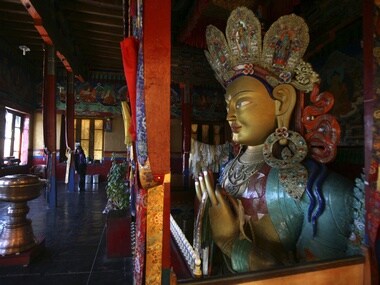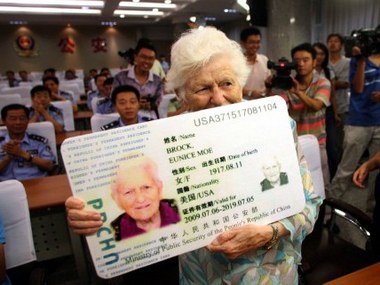Earlier this week, Mohmmed Rizwan, an Indian national who has lived and worked in China for more than 10 years, became perhaps the
first Indian to secure
the right to ‘permanent residence’ in China. With the
right to permanent residence
, which is referred to (somewhat inappropriately) as the Chinese ‘green card’ system, Rizwan, who is married to a Chinese woman, can stay and work in China for five years, without having to renew his visa every year. He will also secure some entitlements and rights on a par with Chinese citizens, and some waivers from paperwork provisions that apply to expatriates in China. [caption id=“attachment_64013” align=“alignright” width=“380” caption=“Eunice Moe Brock from the US shows off her Chinese permanent resident card, or “Green Card”. AFP”]
 [/caption] Rizwan is only one of thousands of Indian nationals who live and work in China, and one of hundreds of thousands of foreigners who have been in China for a long term. These expatriates have fed – and fed off – China’s high-speed economy for the past three decades, and in many cases fill a vacuum in terms of occupations in demand, which Chinese citizens don’t yet have the skills to meet. The rise of Jingaons The number of Indians working for Indian and multinational software services companies operating in China has soared in recent years (to the point where Jinqiao Software Park in Shanghai has, in the popular narrative, been rechristened ‘Jingaon’). So has the number of Indians working in China’s trading hubs – such Guangzhou and Yiwu – who bring you everything that’s made-in-China – from cheap trinkets to home accessories and furnishings to heavy machinery. Many more Indians run flourishing restaurant chains in China (or work in them), and have even have Chinese people eating out of their hands. (Meet two such who have had the whiff of sambar wafting over China:
Mehernosh Pastakia
, and
Munuswamy ‘Antony’ Gnanavelu
, both of whom are married to Chinese women.) In 2008, an Indian woman working in China was chosen to be torchbearer during one leg of the torch relay for the Beijing Olympics; and a Beijing-based
Indian couple served as volunteers
for that sparkling event. A magnet for migrants With its supernormal growth of recent years, China has emerged as a magnet for professionals and entrepreneurs –not just from India - who are looking to ride the Next Big Thing. That’s particularly striking, given that not long ago, the migration flowed only in the reverse direction as Chinese nationals went overseas to build railroads or set up Chinese restaurants or ply their trade – and set up Chinatowns, contributing to the social and cultural diversity of the cities and countries they made their home (from where they
occasionally get the chance to retrace their Chinese roots!
). Today, with economies in the West in decline (despite US Vice-president Joe Biden’s
assertions to the contrary
, as he began his official visit to China), a high-growth China is seen as the go-to place for professionals and businesses alike. As the
New York Times reported
in 2009, “Shanghai and Beijing are becoming new lands of opportunity for recent American college graduates who face unemployment nearing double digits at home.” Continues on next page That breathless report had more than a touch of exaggeration, and was rightly
fisked by a Forbes columnist
, but it does point to a trend reversal in the flow of migration – of foreigners into China. ‘Americatowns in China’ Pondering the decline of employment opportunities in the US, New York Times columnist
Anand Giridharadas wondered
if it would prompt down-and-out Americans to sail away elsewhere in search of better prospects. “Could America, that great nation of immigrants, become in harder times a nation of emigrants? Could the metropolises of China one day have Americatowns?” [caption id=“attachment_64019” align=“alignright” width=“380” caption=“If anything, China has perhaps received more than its fair share of boorish expatriates. Amit Gupta/Reuters”]
[/caption] Rizwan is only one of thousands of Indian nationals who live and work in China, and one of hundreds of thousands of foreigners who have been in China for a long term. These expatriates have fed – and fed off – China’s high-speed economy for the past three decades, and in many cases fill a vacuum in terms of occupations in demand, which Chinese citizens don’t yet have the skills to meet. The rise of Jingaons The number of Indians working for Indian and multinational software services companies operating in China has soared in recent years (to the point where Jinqiao Software Park in Shanghai has, in the popular narrative, been rechristened ‘Jingaon’). So has the number of Indians working in China’s trading hubs – such Guangzhou and Yiwu – who bring you everything that’s made-in-China – from cheap trinkets to home accessories and furnishings to heavy machinery. Many more Indians run flourishing restaurant chains in China (or work in them), and have even have Chinese people eating out of their hands. (Meet two such who have had the whiff of sambar wafting over China:
Mehernosh Pastakia
, and
Munuswamy ‘Antony’ Gnanavelu
, both of whom are married to Chinese women.) In 2008, an Indian woman working in China was chosen to be torchbearer during one leg of the torch relay for the Beijing Olympics; and a Beijing-based
Indian couple served as volunteers
for that sparkling event. A magnet for migrants With its supernormal growth of recent years, China has emerged as a magnet for professionals and entrepreneurs –not just from India - who are looking to ride the Next Big Thing. That’s particularly striking, given that not long ago, the migration flowed only in the reverse direction as Chinese nationals went overseas to build railroads or set up Chinese restaurants or ply their trade – and set up Chinatowns, contributing to the social and cultural diversity of the cities and countries they made their home (from where they
occasionally get the chance to retrace their Chinese roots!
). Today, with economies in the West in decline (despite US Vice-president Joe Biden’s
assertions to the contrary
, as he began his official visit to China), a high-growth China is seen as the go-to place for professionals and businesses alike. As the
New York Times reported
in 2009, “Shanghai and Beijing are becoming new lands of opportunity for recent American college graduates who face unemployment nearing double digits at home.” Continues on next page That breathless report had more than a touch of exaggeration, and was rightly
fisked by a Forbes columnist
, but it does point to a trend reversal in the flow of migration – of foreigners into China. ‘Americatowns in China’ Pondering the decline of employment opportunities in the US, New York Times columnist
Anand Giridharadas wondered
if it would prompt down-and-out Americans to sail away elsewhere in search of better prospects. “Could America, that great nation of immigrants, become in harder times a nation of emigrants? Could the metropolises of China one day have Americatowns?” [caption id=“attachment_64019” align=“alignright” width=“380” caption=“If anything, China has perhaps received more than its fair share of boorish expatriates. Amit Gupta/Reuters”]
 [/caption] India, of course, isn’t lacking in employment opportunities for those with high skills, but as
the testimonials of those who’ve crossed the Himalayas
bears out, China still draws its fair share of Indians – and leaves a lasting impression on them. Which isn’t a surprise at all:
as I noted here
, there is much in China that gives cause for endearment. And despite the
occasional downbeat experience
of visitors from India – and some more extreme circumstances (such as
this
or
this
) - the
foreigner in China
has generally a pleasant time even if there are
some Great Walls that cannot be crossed
in the process of cultural assimilation… If anything, China has perhaps received more than its fair share of boorish expatriates who are overly disrespectful of local customs (see
this video of a Canadian national ranting
at a railway clerk in Wuhan in central China who asked for a copy of his passport in keeping with the real-name registration system for booking tickets), which occasionally lands them in trouble (as happened with
this foreigner who abused
and perhaps struck Guangzhou metro train passengers and was soundly thrashed for his efforts). Which is perhaps why although
China first granted ‘permanent residence’ rights
to foreigners in 2004, it has proceeded only at glacial pace on that front. And it may also be why it is already looking to keep “
unwelcome and unqualified
” immigrants from washing up on its shores. So, while we’re unlikely to see a rollout of the red carpet – and ‘green cards’ - for many more Rizwans, it’s a fair bet that we’ll see more and more ‘Little Indias’ sprouting up in China. Where once Indians looked only to “Go West” in search of fame and fortune, they might perhaps be tempted to occasionally “Look East”’.
[/caption] India, of course, isn’t lacking in employment opportunities for those with high skills, but as
the testimonials of those who’ve crossed the Himalayas
bears out, China still draws its fair share of Indians – and leaves a lasting impression on them. Which isn’t a surprise at all:
as I noted here
, there is much in China that gives cause for endearment. And despite the
occasional downbeat experience
of visitors from India – and some more extreme circumstances (such as
this
or
this
) - the
foreigner in China
has generally a pleasant time even if there are
some Great Walls that cannot be crossed
in the process of cultural assimilation… If anything, China has perhaps received more than its fair share of boorish expatriates who are overly disrespectful of local customs (see
this video of a Canadian national ranting
at a railway clerk in Wuhan in central China who asked for a copy of his passport in keeping with the real-name registration system for booking tickets), which occasionally lands them in trouble (as happened with
this foreigner who abused
and perhaps struck Guangzhou metro train passengers and was soundly thrashed for his efforts). Which is perhaps why although
China first granted ‘permanent residence’ rights
to foreigners in 2004, it has proceeded only at glacial pace on that front. And it may also be why it is already looking to keep “
unwelcome and unqualified
” immigrants from washing up on its shores. So, while we’re unlikely to see a rollout of the red carpet – and ‘green cards’ - for many more Rizwans, it’s a fair bet that we’ll see more and more ‘Little Indias’ sprouting up in China. Where once Indians looked only to “Go West” in search of fame and fortune, they might perhaps be tempted to occasionally “Look East”’.
Venky Vembu attained his first Fifteen Minutes of Fame in 1984, on the threshold of his career, when paparazzi pictures of him with Maneka Gandhi were splashed in the world media under the mischievous tag ‘International Affairs’. But that’s a story he’s saving up for his memoirs… Over 25 years, Venky worked in The Indian Express, Frontline newsmagazine, Outlook Money and DNA, before joining FirstPost ahead of its launch. Additionally, he has been published, at various times, in, among other publications, The Times of India, Hindustan Times, Outlook, and Outlook Traveller.
)